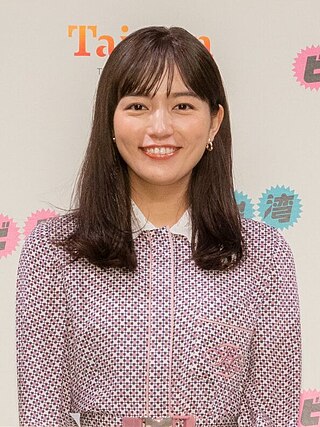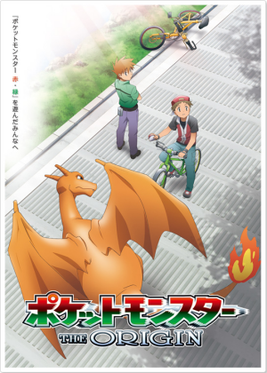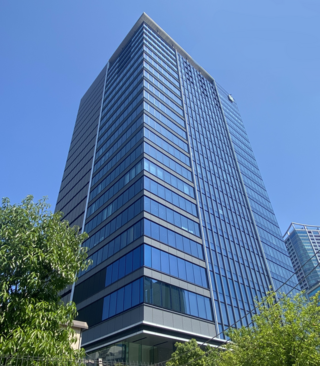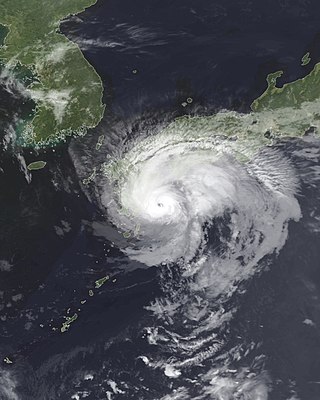
The Japan Broadcasting Corporation, also known as NHK, is a Japanese public broadcaster. NHK, which has always been known by this romanized initialism in Japanese, is a statutory corporation funded by viewers' payments of a television license fee.
Integrated Services Digital Broadcasting is a Japanese broadcasting standard for digital television (DTV) and digital radio.

The mass media in Japan include numerous television and radio networks as well as newspapers and magazines in Japan. For the most part, television networks were established based on capital investments by existing radio networks. Variety shows, serial dramas, and news constitute a large percentage of Japanese evening shows.

A news ticker is a horizontal or vertical text-based display either in the form of a graphic that typically resides in the lower third of the screen space on a television station or network or as a long, thin scoreboard-style display seen around the facades of some offices or public buildings dedicated to presenting headlines or minor pieces of news. It is an evolution of the ticker tape, a continuous paper print-out of stock quotes from a printing telegraph which was mainly used in stock exchanges before the advance of technology in the 1960s.

Sho Sakurai is a Japanese singer, songwriter, rapper, actor, news anchor, host and former radio host. He is a member of the boy band Arashi.
Japan Satellite Television (JSTV) was a Japanese television broadcasting company serving viewers in Europe, the Middle East, and North Africa. Launched in March 1990 and broadcasting from London, it carried the programming from the NHK World Premium service in the regions served.

Takeru Satoh is a Japanese actor. He is best known for his leading role as Ryotaro Nogami in the Kamen Rider Den-O franchise, and as Himura Kenshin in the live-action Rurouni Kenshin film and its sequels.

Ojarumaru (おじゃる丸) is a Japanese anime series created by Rin Inumaru, produced by NHK Enterprises, and animated by Gallop. The series has aired on NHK E-Tele since October 1998, making it the second longest-running anime on NHK behind Nintama Rantaro, and the third longest-running anime series to date. The series focuses on a 5-year-old Heian-era prince named Ojarumaru Sakanoue who accidentally time-warps to modern Japan and has adventures there while dodging a trio of young oni who try to get back a scepter that he stole from Great King Enma. The series has been dubbed in many languages. It was the first NHK anime series to be animated using the digital ink-and-paint process instead of cels.

Heita Kawakatsu was the governor of Shizuoka Prefecture from 2009 to 2024.

Haruna Kawaguchi is a Japanese actress and model under Ken-On. She is known for playing lead roles in Ouran High School Host Club, POV: Norowareta Film, Zekkyō Gakkyū, and Say "I love you".

Yoshimasa Hosoya is a Japanese voice actor and narrator.

Pokémon Origins, known in Japan as Pocket Monsters: The Origin, is a Japanese anime television mini series based on Nintendo's Pokémon franchise which follows the plot of Pokemon Red and Blue. Like the television series, it was not owned by Media Factory. Animation is handled by Production I.G, Xebec, and OLM, Inc., and the film is split into four parts, each directed by a different director from these studios. It was broadcast on TV Tokyo on October 2, 2013, ten days before the release of the X and Y video games, and began streaming internationally on Nintendo's Pokémon TV service from November 15, 2013 to December 2, 2013. On September 14, 2016, the first episode of the series was released for free on the official Pokémon YouTube channel and was later removed in 2017.

A volcanic eruption of Mount Ontake took place on September 27, 2014, killing 63 people. Mount Ontake is a volcano located on the Japanese island of Honshu around 100 kilometres (62 mi) northeast of Nagoya and around 200 km (120 mi) west of Tokyo. It was the first fatal volcanic eruption in Japan since the 1991 eruption at Mount Unzen, and the deadliest volcanic eruption in Japan since Torishima killed an estimated 150 people in 1902.

ABEMA is a Japanese streaming service that launched on April 11, 2016, under the name AbemaTV. It is majority-owned by CyberAgent, with a 55.2% stake, and TV Asahi, with a 36.8% stake, while the remaining ownership belongs to various other companies, mostly in the media and entertainment industry.

Typhoon Francisco was a small tropical cyclone that impacted Japan and the Korean Peninsula in August 2019. Originating from a trough over the open Pacific Ocean on July 29, Francisco developed into a tropical depression on August 1. Tracking along a northwest course toward Japan, the system steadily intensified over the following days. It attained typhoon strength on August 5 and soon struck Kyushu at peak strength with winds of 130 km/h (80 mph). Thereafter, the weakened storm traversed the Korea Strait before striking South Korea on August 6. Turning toward the east, Francisco transitioned into an extratropical cyclone on August 7. It later impacted Hokkaido before continuing across the northern Pacific and dissipating.

Typhoon Talim, known in the Philippines as Typhoon Lannie, was an intense and destructive tropical cyclone that affected parts of East Asia, especially Japan, during September 2017. The eighteenth named storm and the sixth typhoon of the 2017 Pacific typhoon season, Talim's origins can be traced back to an area of low-pressure that the Joint Typhoon Warning Center first monitored on September 6. The disturbance was upgraded to a tropical depression by the Japan Meteorological Agency only two days later, and it became a tropical storm on September 9, earning the name Talim. Talim grew stronger over the next few days, eventually becoming a typhoon the next day. Within a favorable environment, the typhoon rapidly intensified after passing through the Ryukyu Islands. However, as it moved eastward, Talim started to weaken due to wind shear, and on September 16, it was downgraded to a tropical storm. The storm passed over Japan, near Kyushu the next day, before becoming extratropical on September 18. The extratropical remnants were last noted by the JMA four days later, before dissipating fully on September 22.
TwitCasting is a livestreaming service operated by Moi Co., Ltd., headquartered in Tokyo, Japan. In early 2013, TwitCasting was developed as a way to use the Twitter feed to stream content from smartphones directly onto a user's channel. As of July 2021, it had over 33 million registered users. As of March 2020, it had the most monthly active users among livestreaming apps in Japan, according to App Ape Lab analytics.

"Aldebaran" is a song recorded by Japanese-American singer-songwriter Ai, released on November 1, 2021, by EMI Records and Universal Music Group. The song served as the theme song for the Japanese television drama, Come Come Everybody and subsequently served as the third single from Ai's twelfth studio album, Dream.

Typhoon Hinnamnor, known in the Philippines as Super Typhoon Henry, was a very large and powerful tropical cyclone that impacted Japan, South Korea, Taiwan, the Philippines, and Russia. The eleventh named storm, fourth typhoon, and the 1st super typhoon of the 2022 Pacific typhoon season, Hinnamnor originated from a disturbed area of weather first noted on August 27 by the JTWC. This area soon formed into Tropical Storm Hinnamnor on the next day. The storm rapidly intensified and became a typhoon on the August 29. Overnight, Hinnamnor cleared a small eye along with a well-defined CDO, and intensified into a high-end Category 4-equivalent super typhoon.

TVer is a Japanese ad-supported video on demand (AVOD) service. It was established in October 2015 by the five commercial broadcasters in Tokyo: Nippon TV, TV Asahi, TBS Television, TV Tokyo, and Fuji Television. It allows viewers to watch TV programs they missed during their initial broadcast for free for one week. Additionally, the service offers simultaneous streaming, allowing viewers to watch programs at the same time as their TV broadcast.






















